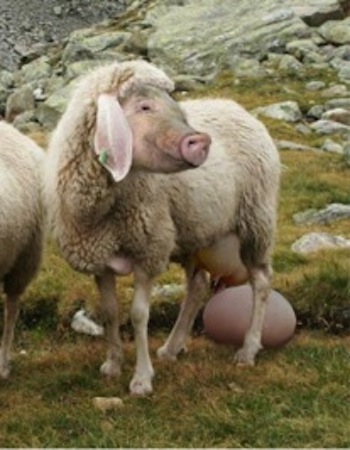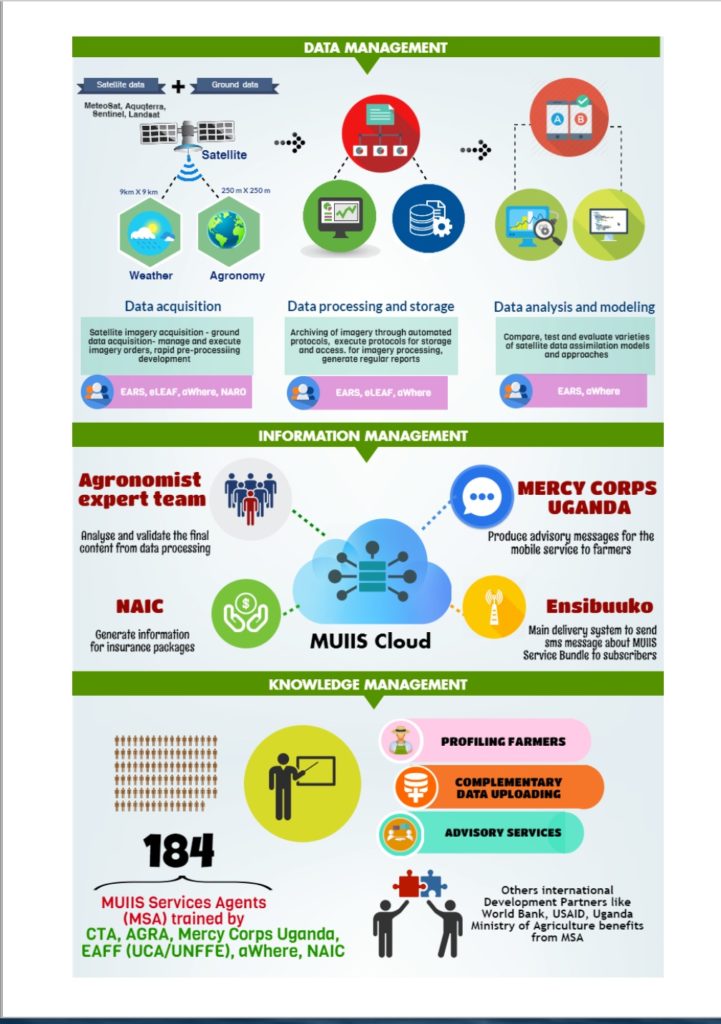
Search
“Eierlegende Wollmilchsau.” Part pig, sheep, chicken and cow – this “marvel of German (bio)engineering” can do just about anything. But as Gabriel Krieshok, a startup founder, consultant and former Peace Corps ICT4D Program Manager writes:
“The tragedy of the egg-laying-wool-milk-sow is that it’s a single animal that contains all the positive attributes of a variety of animals and can perform many functions. Except, of course, it’s a fantasy.” (Read More)

Source: Wikimedia Commons. Author: Georg Mittenecker
This German colloquialism is the perfect metaphor for the one-size-fits-all, Swiss Army Knife theory of ICT4D or, in this case, ICT4Ag. It’s the notion that a good way to use technology to help farmers in developing countries is by building products from scratch that incorporate the full technology stack and a range of services or functionality in a custom vertical configuration. The alternative is “bundling,” or connecting existing software, database and service products from multiple providers in a horizontal system.
“To be fair, particularly in Kenya, I see a lot of farmer-centric AgTech innovation going on. iProcure, Esoko, and FarmDrive come to mind as organizations that are laser focused on building “full-stack” ICT4Ag startups with a clear value proposition for the end-user farmers,” writes TaroWorks CEO Brent Chism. “But you don’t need to be a full-stack, vertically integrated startup to provide farmer-relevant AgTech features, especially if those features result from needs expressed by your end users.” (Read More)
Companies like TaroWorks, which offers a mobile data collection and analysis app and offline field service management system powered by Salesforce.com, have created horizontal platforms that some agricultural organizations use in conjunction with other apps and partners (as an alternative to vertically integrated solutions) to manage networks of extension workers or sales and distribution field agents.
There’s no shortage of Agtech solutions that NGOs, social enterprises and commercial vendors are deploying with the goals of increasing farmer productivity, reducing cost and opening access to larger markets.
“There is a dizzying number of ICT4Ag innovations – from remote and in-situ sensing tools to big data platforms – that can improve decision-making among farmers, suppliers and governments. Rising smartphone penetration and improving connectivity, along with improved data processing and analytics capabilities, offer us the opportunity to adapt and bring these improved solutions to smallholder farmers at a fraction of the cost of traditional methods,” writes Christian Merz, Senior Program Officer Digital Solutions at the Bill & Melinda Gates Foundation.
“Yet most players are not yet translating momentum into impact at scale. Lack of evidence, challenging economics and poor understanding of the consumer, among others, continue to hamper the success of digital solutions … The most successful ICT4Ag grants of the Bill & Melinda Gates Foundation built upon the ability to convene and coordinate disparate actors towards a common goal.” (Read More)
Merz sees six areas that could support funding and a technology focus: “rural advisory services, financial access, farm management, supply chain management, market access, and agricultural intelligence and knowledge.” Can bundling software and services help reach scale in these or other areas? Alice Van der Elstraeten, an Information Management Specialist at The Food and Agriculture Organization of the United Nations (FAO), believes so:
“We can work much much better on bundling ICT functionality such as digital finance, marketing, surveillance, supply management, extension. They could all be bundled on the same platform. This is essential to be able to achieve economies of scale and to enhance the benefits these platforms can bring to farmers. If we find bundled and cross sectional ICT technologies that can work for a community, we would really make a good step forward. “ (Read More)
Here are two examples of efforts focused on a bundled or modular approach to ICT4Ag software and service development.
Market-led, User-owned ICT4Ag-enabled Information Service (MUIIS): Launched in Uganda in March 2017, the service provides “context-specific weather alerts (via satellite), agronomic tips and index-based insurance” with the goal of reaching an estimated 350,000 maize, beans, sesame and soybean smallholder farmers to help increase crop yields, farmers’ incomes and the effective use of inputs like fertilizers and pesticides.
The project is structured around a partnership of data, service and software organizations including aWhere, which supplies agronomic, weather and other information from its external platform; Ensibuuko, which provides mobile money payment functionality; EARS, which created an SMS-delivered crop insurance product that tracks drought severity during the growing season; Ona, which facilitates field data collection and Mercy Corps, which – among other roles – offers farmers best practice and other extension information while also handling project management. A consortium led by the Technical Centre for Agricultural and Rural Cooperation (CTA) and including the Alliance for a Green Revolution in Africa (AGRA) and the East African Farmers’ Federation (EAFF), was awarded a €4.6 million grant by The Netherlands Space Office (NSO) to fund the program. (Read More)

Source: The Technical Centre for Agricultural and Rural Cooperation (CTA)
FarmerLink: This Grameen Foundation project “connects coconut farmers (in the Philippines) with a range of services and information: from agricultural loan products and micro-insurance to real-time weather data to advice on crop pest management. Together, these services help farmers strengthen their businesses, build resilience, and mitigate losses due to changing climate and extreme weather.” (Read More)
It’s a strategic alliance with data from aWhere being distributed via SMS and TaroWorks’ mobile data collection and analysis app – as well as our offline field service management platform and Salesforce cloud database. These tools are used to manage a program designed to increase farmer income by providing certification of what they produce in hopes of making stronger connections to the value chain and remaining compliant with sustainability and quality assurance standards. The range of partners include buyers, financial institutions, and agriculture extension agency and additional messaging platforms (early warning system, engageSpark).

Source: Grameen Foundation
While developing a customized, full-stack ICT4Ag platform makes perfect sense in a range of cases (including when an organization has strong internal tech resources, the project has complicated business requirements or there exists a well-functioning legacy system), both full-stack (vertical) and bundled software (horizontal) ICT4Ag projects face similar challenges in developing business models to make either technology platform sustainable.
In a study of fifteen ICT4Ag solution providers in Kenya, Tanzania and Ghana, AGRA identified strengths, weaknesses and areas of possible improvement in the development of business models to sustain ICT4Ag solutions. To paraphrase a number of the findings and recommendations, while not necessarily endorsing them all:
Business Model Flaws
Business Model Strengths
Business Model Recommendations
In June 2017, TaroWorks assembled a panel of experts to share their thoughts on the future of ICT4Ag, especially as it applies to mobile agriculture. Listen to their thoughts in this webinar. They identified two channels as among the most promising for bundling ICT4Ag software, services and functionality: (1). Marketing – Information connecting farmers to markets, agriculture extension, supply chain management and surveillance, (2). Money – Local and regional agribusinesses are increasingly getting interested in moving to digital payments for their farmers, especially with the proliferation of mobile money.
The consensus of the panel – admittedly a group already focused on bundling applications – was that this development approach maximizes the value proposition for the farmer by directly connecting them to the supply chain. At the same time, the strategy maximizes the value proposition for the anchor agribusiness, the mobile money channel and anybody else who’s part of the strategic alliance.
What is also helping spark momentum for bundling are products like Zapier and OpenFN, which automate the flow of information between multiple technologies, making it possible to connect APIs without significant development time and expertise.
The challenge is how to get all of the data to work together? TaroWorks believes that the single source of connections is the farmer’s identity. By tying it at that level, we’re essentially creating a farmer relationship management system. Whatever form the system takes, that core identity should be the farmer.
POST TOPICS
PREVIOUS POST
Sign up to receive emails with TaroWorks news, industry trends and best practices.
TaroWorks, a Grameen Foundation company.
Site by V+V